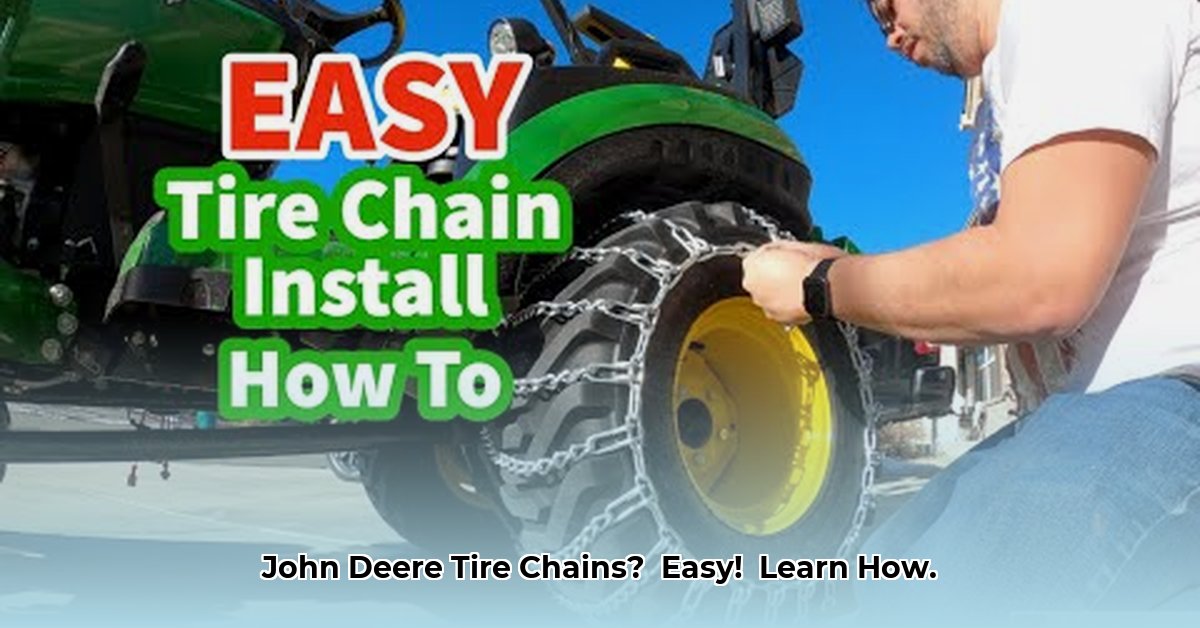
Winter's harsh conditions can significantly impact farm operations. Ensuring your John Deere tractor maintains optimal traction is crucial for safety and productivity in snow, ice, or mud. Tire chains provide the necessary grip, but proper installation is paramount. This guide offers a detailed, step-by-step process for safely and effectively installing tire chains on your John Deere tractor. Mastering this skill minimizes risk and maximizes your tractor's performance in challenging conditions. For more tractor operation tips, see John Deere operation.
Essential Tools and Materials: Preparation is Key
Before beginning, gather all necessary tools and materials. This ensures a smooth and safe installation process. Having everything readily available prevents delays and potential hazards.
- Tire Chains: Select chains appropriate for your John Deere tractor's tire size and the type of terrain (snow, ice, mud). Consider heavier-duty chains for extreme conditions. [Link to reputable online retailer selling John Deere compatible chains]
- Jack: A reliable jack, specifically rated for your tractor's weight, is essential for safely lifting the wheel. Never compromise on safety; use a jack with a higher weight capacity than your tractor's wheel weight.
- Wheel Chocks: These are crucial for stabilizing the tractor during the installation process. Always use wheel chocks, even on level ground.
- Gloves: Protect your hands from potential scrapes and cold temperatures.
- Wrench: Select a wrench sized appropriately to tighten the chain tensioners securely.
- Chain Lubricant (optional): A chain lubricant helps extend the life of your chains and reduces friction.
Choosing the Right Chains: A Match Made in Heaven
Selecting the correct chains is vital for both safety and effectiveness. Improperly sized or designed chains compromise traction, potentially leading to dangerous situations.
- Tire Size: Verify your tractor's tire size on the tire sidewall. This crucial measurement dictates the appropriate chain size.
- Terrain: Different terrains necessitate different chain designs. Snow and ice chains feature tighter cross-chains for improved grip; mud chains often employ wider links for weight distribution.
- Link Style: Two-link chains offer a smoother ride on paved surfaces (for brief transitions); four-link chains provide more aggressive traction in snow or ice.
- Studs: Studded chains offer superior ice grip but may damage paved surfaces; check local regulations before using them.
| Chain Type | Ideal Terrain | Advantages | Disadvantages |
|---|---|---|---|
| Two-Link | Paved, light snow | Smooth ride, less road damage | Less aggressive traction in deep snow/ice |
| Four-Link | Snow, ice | Excellent grip on snow and ice | Noisier, potential road damage |
| Studded Chains | Ice | Superior ice traction | Significant potential for road damage |
| Heavy-Duty Chains | Extreme conditions | Superior strength and longevity | More challenging to install |
Consult your John Deere owner's manual or a local dealer for personalized recommendations based on your tractor model and typical operating conditions.
Step-by-Step Chain Installation: A Precise Process
This section details the installation procedure. Prioritize safety throughout each step. Always engage the parking brake before commencing and use wheel chocks.
- Preparation: Securely chock the wheels. Use the jack to carefully lift the wheel. Ensure stability and levelness. Remove any debris around the wheel.
- Positioning: Fully open the chains. Drape them around the tire, ensuring the curved side faces inward and cross-chains rest on top.
- Connecting: Connect the chain ends firmly, avoiding tangles or twists.
- Tightening: Use the wrench to snug the chain tensioners. The chains should be snug but allow for tire rotation.
- Lowering the Wheel: Gradually lower the wheel, watching for even chain descent.
- Rotation and Adjustment: Rotate the wheel to verify even chain distribution, and address any kinks or twists.
- Final Tension Check: After a short test drive, re-check and adjust tension as needed.
Tension Adjustment and Regular Inspection: Ongoing Maintenance
Maintaining proper chain tension is continuous and crucial. Loose chains are ineffective and hazardous, while overly tight chains can damage tires or rims. Regularly inspect chains during and after use, adjusting tension as needed to ensure a secure yet flexible fit. Don't overtighten.
Maintenance and Storage: Extending Chain Lifespan
Proper maintenance extends the service life of your chains. After each use, clean them thoroughly to remove mud and debris. Applying chain lubricant to the links reduces wear and tear. Store chains flat, in a dry location, to prevent rust and damage.
Troubleshooting: Addressing Common Installation Problems
If you encounter difficulties during installation, consult your John Deere owner's manual. It may contain diagrams or troubleshooting tips specific to your tractor model. If problems persist, contact your local John Deere dealer for assistance from experienced technicians.
Conclusion: Prioritize Safety and Performance
Correctly installing and maintaining tire chains is vital for both the safety and efficiency of your John Deere tractor operations during challenging winter conditions. Though this guide offers comprehensive instruction, always refer to your owner's manual for specific instructions and guidance. Remember, prioritizing safety is paramount.